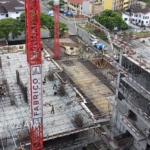
This article seeks to rebut a publication by the Daily Graphic dated Monday, October 28, 2024, under the heading, “Don’t Use Bamboo to Hold Concrete.” In the said publication, the writer referred to Engineer Henry Boateng, the president of the Institution of Engineers and Technology (IET) – Ghana, as the main resource person for the write-up.
The supposed personnel made some seriously misleading pronouncements against the use of bamboo as reinforcement in concrete works, as opposed to that of iron rods.
Well, as the official founder of this all-important technology and a beneficiary award winner of this project, both internationally and locally, including but not limited to the coveted Socrates Award for Quality and Innovation received in Rome, Italy, almost a decade ago, I deemed it necessary to correct the wrong impression put out there by someone or a group of people who are supposed to know better but unfortunately did otherwise for reasons I can only guess are either complete ignorance or a deliberate attempt to degrade all the hard work put into this research by my organization. Hence this piece.
In addressing this issue, this article picks up on the key reasons the resource personnel gave, compares and contrasts them with those of iron rods, analysing them scientifically, socially, and environmentally, leaving the socioeconomic and other analyses for another day. In the end, I will draw a conclusion for my readers’ judgment.
Reasons Given:
- The alkaline content of the cement may weaken the strength of the bamboo when it comes into contact.
In Ghana and mostly across the world, Portland cement is the main binding agent used for almost all concrete work. These types come in either 32.5R or 42.5R, depending on the strength one is looking for in the mix. Research has shown that the alkaline content in these cement types ranges from 0.4% to 1.6% depending on the raw materials used and not the brand. Source: (Science Direct)
Therefore, whether one uses 32.5R or 42.5R, the alkaline (NaOH) content will remain within the above-stated range. Research has also proven that matured bamboo’s tensile ability will rather increase as the alkaline content increases to over 20% to 25% before it starts failing with more alkaline presence. (Source: ScienceDirect.com)
My argument is this: how can our Portland cement, with an alkaline content of less than 2% destroy the tensile strength of the matured bamboo when it requires about 25% or above before it begins to weaken its tensile ability?
In contrast, alkaline will improve the tensile strength of the bamboo up to a concentration of, say, above 20% before it starts affecting it negatively. Our Portland cement can only provide up to a maximum of 2% and therefore cannot cause any harm to the strength of the bamboo in any case. Hence, that assertion is completely false scientifically.
- Bamboo expands by absorbing water with wet concrete, so when the concrete dries, there will be space between the bamboo and the dried concrete.
Yes, the easy expansion and contraction of bamboo in wet and dry concrete, respectively, is a special feature that allows bamboo to easily adapt to any kind of concrete mix and environment compared to iron rods. Undoubtedly, bamboo may expand in the wet concrete, but it will also shrink back to its original shape and size as the concrete cures. Therefore, bamboo, in short, will expand and contract with the concrete in proportional levels and hence leave no space between the dried concrete and the dried bamboo, contrary to what the president is proposing.
Iron rods may equally expand and contract over time in concrete. Although they may not expand immediately within the wet environment, their inability to easily expand and contract in different environments makes their adaptation quite complex compared to that of bamboo. This may lead to several cracking problems from drying shrinkage and easy rusting of the metal in a salty environment.
In contrast, in terms of bamboo’s ability to expand and contract in the wet concrete, it becomes an added advantage over that of the iron rods and therefore should not be seen as a problem but rather, a valuable asset of bamboo.
- Bamboo Will Decompose Over Time; hence, Not Suitable for concrete work.:
Well, iron rods will equally rust and even faster when exposed to a salty environment without the right amount of chemical treatment; hence, this argument falls short.
Generally, decomposition in organic materials occurs when agents like fungi, bacteria, and insects break down organic matter into simpler components. It is basically a natural process influenced by factors such as temperature, moisture, and oxygen. ( Source: Wikipedia.org).
From the above definition, decomposition, as proposed by the said engineer, is most unlikely when the bamboo is buried in the concrete. It becomes like an “embalmed dead body” and can last for centuries unless the strength of the concrete is compromised and the bamboo is exposed. Until such a time, the concrete material around the bamboo naturally forms the ‘protective coat” so long as the bamboo remains in the concrete without exposure to the atmosphere.
There is therefore no reason to believe that bamboo in concrete will decompose without exposure to the atmosphere or other agents that may cause it to do so, as proposed by the President.
- Bamboo does not match the tensile strength of steel but possesses a High Tensile Strength and an excellent strength-to-weight ratio.
In contrast, matured bamboo has a tensile strength comparable to or even higher than some types of mild steel, with figures ranging from around 100-300MPa (14,500.43,500psi ) for bamboo and 250-415MPa (36,000-60,000psi) for mild steel, and 400-1000MPa or 58,000-145,000psi) for high tensile steel. (Source: Science Direct.) This means that, except for high-tensile steel, mature bamboo can match the strength of any of these regular mild steels at any point in time.
Again, as the President Engineer humbly admitted, it is true that mature bamboo has an excellent strength-to-weight ratio compared to that of iron rods. As part of my research, we have figures not less than six times greater, depending on the breed. Hence, to compensate for any loss in tensile strength during structural design using bamboo, all one has to do is double or increase the quantity of bamboo being used until the needed strength is attained. This may not necessarily overload the dead weight of the entire structure. It is important to note that the same cannot be said for the iron rods. These qualities and many others give bamboo an additional advantage over iron rods.
- Economic Benefit.
Aside from the many other uses of bamboo in the construction industry, which time and space do not allow me to mention here, the cost of bamboo is far cheaper than that of iron rods in any part of the world; hence, there is no need for me to discuss the economic impact on construction projects when properly used. In Ghana, for example, the cost of one ton of bamboo is about ten times cheaper than that of ordinary mild steel rods, if not more.
- Environmental Impact.
Iron rod production always comes with a huge negative impact on the environment in terms of energy consumption and the amount of heat and carbon dioxide that is released into the atmosphere, leading to climate changes such as global warming and other related climate issues. For example, in the production of every one ton of iron rods, about 400-700 kWh of electricity is used, and this also produces about 1.8 tons of CO2 in additional emissions into the atmosphere. Source: steelonthenet.com
Alternatively, the production of bamboo will provide more oxygen to the atmosphere, thereby making the environment friendlier, as plants absorb carbon dioxide (CO2) and give off oxygen during the process of photosynthesis.
- Social Impact.
The use of bamboo in place of iron rods in modern-day buildings will demystify the social misconceptions and beliefs that high-rise buildings and other strong reinforced structures belong to a certain class of people. It seeks to bring building and otherwise sophisticated construction home to the ordinary; hence, the need to encourage its use within our local communities.
That said, I wish to state that mature bamboo’s ability to provide the needed tensile strength in concrete works exists in nature and hence is scientific. Therefore, no amount of propaganda can alter that.
Conclusion.
In conclusion, let me admit that most of my research work in this area has not been officially published to provide others who may want to use bamboo as a reinforcement method. However, that publication was very misleading, especially coming from that source, and it needs to be completely disregarded and treated with the contempt it deserves. In the interim, I will be attaching some of my research works on bamboo, and at the appropriate time, I will publish the first volume of my book on bamboo structural reinforcement.
–
By: Kofi Anokye, CEO, Koans Group.
( LLM, LLB, MBA, BSC, HND, B-TECH.)




